The Evolution of C Programming Practices:
A Study of the Unix Operating System 1973-2015
Diomidis Spinellis
Panos Louridas
Maria Kechagia
Athens University of Economics and Business
Patision 76, GR-104 34 Athens, Greece
Abstract
Tracking long-term progress in engineering and applied science allows us to take stock of things we have achieved, appreciate the factors that led to them, and set realistic goals for where we want to go. We formulate seven hypotheses associated with the long term evolution of C programming in the Unix operating system, and examine them by extracting, aggregating, and synthesising metrics from 66 snapshots obtained from a synthetic software configuration management repository covering a period of four decades. We found that over the years developers of the Unix operating system appear to have evolved their coding style in tandem with advancements in hardware technology, promoted modularity to tame rising complexity, adopted valuable new language features, allowed compilers to allocate registers on their behalf, and reached broad agreement regarding code formatting. The progress we have observed appears to be slowing or even reversing prompting the need for new sources of innovation to be discovered and followed.CCS Concepts
• Software and its engineering → Software evolution; Imperative languages; Software creation and management; Open source model; • General and reference → Empirical studies; Measurement; • Social and professional topics → Software maintenance; History of software;Keywords
C; coding style; coding practices; Unix; BSD; FreeBSD1 Introduction
Tracking long-term progress in engineering and applied science allows us to take stock of things we have achieved, appreciate the factors that led to them, and set realistic goals for where we want to go. Progress can be tracked along two orthogonal axes. We can look at the processes (inputs) or at the resulting artefacts (outputs). Furthermore, we can examine both using either qualitative or quantitative means. The objective of this work is to study the long term evolution of C programming in the context of the Unix operating system development. The practice of programming is affected by tools, languages, ergonomics, guidelines, processing power, conventions, as well as business and societal trends and developments. Specific factors that can drive long term progress in programming practices include the affordances and constraints of computer architecture, programming languages, development frameworks, compiler technology, the ergonomics of interfacing devices, programming guidelines, processing memory and speed, and social conventions. These might allow, among other things, the more liberal use of memory, the improved use of types, the avoidance of micro-optimisations, the writing of more descriptive code, the choice of appropriate encapsulation mechanisms, and the convergence toward a common coding style. Here are a few examples. The gradual replacement of clunky teletypewriters with addressable-cursor visual display terminals in the 1970s may have promoted the use of longer, more descriptive identifiers and comments. Compilers using sophisticated graph colouring algorithms for register allocation and spilling [12] may have made it unnecessary to allocate registers in the source code by hand. The realisation that the overuse of the goto statement can lead to spaghetti code [13] might have discouraged its use. Similarly, one might hope that the recognition of the complexity and problems associated with the (mis)use of the C preprocessor [48,34,15,49] may have led to a reduced and more disciplined application of its facilities. Also, one would expect that the introduction and standardisation of new language features [45,2,23] would lead to their adoption by practitioners. Finally, the formation of strong developer communities, the maturing of the field, and improved communication facilities may lead to a convergence on code style. In more formal terms, based on a simple-regression exploratory study [54], we established the following hypotheses, which we then proceeded to test with our data. H1: Programming practices reflect technology affordances If screen resolutions rise we expect developers to become more liberal with their use of screen space, as they are no longer constrained to use shorter identifiers and shorter lines. Higher communication bandwidth (think of the progress from a 110 bps ASR-33 teletypewriter, to a 9600 bps VT-100 character addressable terminal, to a 10MB Ethernet-connected bitmap-screen workstation) makes typing more responsive and the refresh of large code bodies faster. Similarly, if barriers imposed to compilation unit sizes by the lack of memory or processing capacity are removed, we expect developers to abandon artificially-imposed file size limits, and move towards longer files packed with more functionality. H2: Modularity increases with code size As the Unix source code evolves and multiplies in size and complexity we expect developers to manage this growth through mechanisms that promote modularity. These include the use of the static keyword to limit the visibility of globally visible identifiers, and the pairing of header files with C implementation into discrete modules. H3: New language features are increasingly used to saturation point The C language has been changing over time with new features being added, albeit sparingly. We expect them to be increasingly used after being introduced, up to a point - certainly, a language feature can only be used a certain number of times in a program. For example, when the unsigned keyword was introduced, it could in theory, be used at most on all integer definitions and declarations of a program, and in practice only on those where the underlying value was indeed non-negative. We call this limit the feature's saturation point. H4: Programmers trust the compiler for register allocation In the days of yore, programmers had to deal themselves with the nitty-gritty details of register allocation by declaring variables with the register keyword. As compiler technology has improved, compilers have become more adept at the task. We expect that developers have been noticing this and have therefore been more and more trusting of the compilers with handling register allocation optimizations. H5: Code formatting practices converge to a common standard We expect developers working on a single project, such as Unix, to adopt a common coding standard, making the code base more homogeneous over time. This can be aided through the increased availability and use of collaboration mechanisms such as version control systems and online communities. H6: Software complexity evolution follows self correction feedback mechanisms We expect that as software evolves it becomes more complex, to a degree. A successful project cannot grow in complexity beyond the confines of human comprehension. Therefore we also expect that beyond a certain point self correction feedback mechanisms should kick in, bringing code complexity down. H7: Code readability increases As software and its development process and community evolve, growing in size and in complexity (to a degree), we expect its readability to increase, in order to make it manageable by its evolving community of developers. In addition, a long lived project will outlive its original developer cast and accommodations must be made for new cohorts. The preceding hypotheses can be tested by examining instances of the code over time. By looking at the long term evolution of associated metrics we can determine whether they indeed change over time, as well as the direction and rate of change. The results of the study on long term evolution of programming practices can be used to allocate the investment of effort in areas where progress has been efficiently achieved, and to look for new ways to tackle problems in areas showing a lack of significant progress. Also, given the hypothesis that the structure and internal quality attributes of a working, non-trivial software artefact will represent first and foremost the engineering requirements of its construction [51], the results can also indicate areas where developers rationally allocated improvement effort and areas where developers did not see a reason to invest. This paper builds on the earlier short exploratory study [54] by explicitly stating and testing hypotheses, by using a more sophisticated statistical method for the analysis, by a detailed explanation of the employed methods, and by presenting possible causality links between external changes, the metrics, and the hypotheses. To formulate the hypotheses we took into account the general technological trends, such as improved screen technologies and software techniques, combined with metrics, which we could measure from our data and could bear on the trends. In the following sections we describe the methods of our study (Section 2), we present and discuss the results we obtained (Section 3), and outline related work (Section 4). Section 5 summarises our conclusions and provides directions for further work.2 Methods
Our study is based on a synthetic software configuration management repository tracking the long term evolution of the Unix operating system. At successive time points of significant releases we process the C source code files with a custom-developed tool to extract a variety of metrics for each file. We then synthesise these metrics into weighted values that are related to our hypotheses, and analyse the results over time using established statistical techniques.2.1 Data Collection and Primary Metrics
The analysis of the Unix source code over the long term was made possible by the fact that important Unix material of historical importance has survived and is nowadays openly available. Although Unix was initially distributed with relatively restrictive licenses, significant parts of its early development have been released by one of its rights-holders (Caldera International) under a liberal license. Additional parts were developed or released as open source software by (among others) the University of California, Berkeley and the FreeBSD Project. The primary sources of the material used in this study include source code snapshots of early released versions, which were obtained from the Unix Heritage Society archive, the CD-ROM images containing the full source archives of Berkeley's Computer Science Research Group (CSRG), the OldLinux site, and the FreeBSD archive. These snapshots were merged with past and current repositories, namely the CSRG SCCS [46] repository, the FreeBSD 1 CVS repository, and the Git mirror of modern FreeBSD development. This material plus results of primary research regarding authorship and genealogy formed the basis for constructing a synthetic Git repository, which allows the efficient retrieval and processing of the Unix source code covering a period of 44 years [52].| Name | Mean File Date | LoC |
| Research-V3 | 1973-08-30 | 5,963 |
| Research-V5 | 1974-11-27 | 27,429 |
| Research-V6 | 1975-06-03 | 49,630 |
| BSD-1 | 1977-12-09 | 55,378 |
| Bell-32V | 1978-12-13 | 163,643 |
| Research-V7 | 1979-01-31 | 157,003 |
| BSD-2 | 1979-05-06 | 88,048 |
| BSD-3 | 1979-08-18 | 269,646 |
| BSD-4 | 1980-06-22 | 373,881 |
| BSD-4.1 snap | 1981-04-09 | 447,540 |
| BSD-4.1c 2 | 1989-01-03 | 564,883 |
| BSD-4.2 | 1990-06-23 | 683,428 |
| 386BSD-0.0 | 1991-05-13 | 655,191 |
| 386BSD-0.1 | 1991-06-08 | 768,469 |
| BSD-4.3 | 1991-12-03 | 1,117,677 |
| BSD-4.3 Tahoe | 1992-06-21 | 1,315,451 |
| BSD-4.3 Net 2 | 1993-07-02 | 1,445,124 |
| FreeBSD 1.0 | 1993-07-02 | 3,515,680 |
| FreeBSD 1.1 | 1993-09-17 | 1,519,925 |
| FreeBSD 1.1.5 | 1993-11-16 | 1,698,792 |
| BSD-4.3 Net 1 | 1993-12-25 | 179,292 |
| BSD-4.4 Lite1 | 1994-01-15 | 2,436,446 |
| BSD-4.4 Lite2 | 1994-01-20 | 2,487,503 |
| BSD-4.4 | 1994-01-27 | 2,828,398 |
| BSD-4.3 Reno | 1994-02-26 | 1,217,391 |
| FreeBSD 2.0 | 1994-10-09 | 6,152,630 |
| FreeBSD 2.0.5 | 1995-01-12 | 2,154,728 |
| FreeBSD 2.1.0 | 1995-02-19 | 2,204,647 |
| FreeBSD 2.1.5 | 1995-05-20 | 2,254,479 |
| FreeBSD 2.1.6 | 1995-05-31 | 2,266,688 |
| FreeBSD 2.2.5 | 1996-05-05 | 2,615,395 |
| FreeBSD 2.2.6 | 1996-08-07 | 2,679,569 |
| FreeBSD 2.2.7 | 1996-09-16 | 2,710,214 |
| FreeBSD 3.0.0 | 1997-07-04 | 3,371,194 |
| FreeBSD 3.2.0 | 1997-08-26 | 3,527,404 |
| FreeBSD 3.3.0 | 1998-03-19 | 3,575,250 |
| FreeBSD 3.4.0 | 1998-04-22 | 3,656,716 |
| FreeBSD 3.5.0 | 1998-05-17 | 3,684,268 |
| FreeBSD 4.0.0 | 1999-03-29 | 4,422,666 |
| FreeBSD 4.1.0 | 1999-05-30 | 4,632,772 |
| FreeBSD 4.1.1 | 1999-06-29 | 4,689,328 |
| FreeBSD 4.2.0 | 1999-07-16 | 4,717,764 |
| FreeBSD 4.3.0 | 1999-09-27 | 4,786,370 |
| FreeBSD 5.0.0 | 2001-11-02 | 5,434,960 |
| FreeBSD 4.4.0 | 2002-02-03 | 4,881,244 |
| FreeBSD 5.1.0 | 2002-03-22 | 5,490,790 |
| FreeBSD 4.6.0 | 2002-07-03 | 5,050,687 |
| FreeBSD 5.2.0 | 2002-08-23 | 5,706,097 |
| FreeBSD 4.7.0 | 2002-10-05 | 5,184,702 |
| FreeBSD 5.3.0 | 2004-10-16 | 6,093,719 |
| FreeBSD 5.4.0 | 2005-04-20 | 6,126,108 |
| FreeBSD 6.0.0 | 2005-10-09 | 6,330,668 |
| FreeBSD 7.1.0 | 2005-12-09 | 7,401,793 |
| FreeBSD 7.2.0 | 2006-01-19 | 7,501,567 |
| FreeBSD 6.1.0 | 2006-04-30 | 6,424,602 |
| FreeBSD 6.2.0 | 2006-11-14 | 6,530,096 |
| FreeBSD 8.0.0 | 2007-02-21 | 8,016,942 |
| FreeBSD 8.1.0 | 2007-05-08 | 8,152,027 |
| FreeBSD 8.2.0 | 2007-07-22 | 8,358,507 |
| FreeBSD 6.3.0 | 2007-11-24 | 6,614,077 |
| FreeBSD 7.0.0 | 2007-12-22 | 7,231,515 |
| FreeBSD 9.0.0 | 2008-09-22 | 9,230,038 |
| FreeBSD 9.1.0 | 2009-02-01 | 9,497,551 |
| FreeBSD 9.2.0 | 2009-06-09 | 9,674,294 |
| FreeBSD 9.3.0 | 2009-10-29 | 10,048,538 |
| FreeBSD 10.0.0 | 2010-11-09 | 10,767,581 |
| (1) |
2.2 Derived Metrics

C preprocessor macros can often be replaced by exploiting newer language features, such as enumerations and inlined functions. However, these features and header file inclusion require additional processing power and more sophisticated compiler support. We end the description of the factors associated with the metrics we tracked by noting that the annotation of code through colourful symbols and swearwords (DKLUDGE ), is a matter of convention, which may be fading, being replaced by comments in issue tracking systems, online forums, and configuration management tools."Another major change in V7 was that Unix data structure declarations were now documented on header files, and included. Previous Unixes had actually printed the data structures (e.g., for directories) in the manual, from which people would copy it into their code. Needless to say, this was a major portability problem."
2.3 Statistical Analysis
We subjected the derived aggregate metrics to statistical analysis in order to discern longitudinal trends. As all the metrics we collected were ordered by date, we performed regression analysis with the days elapsed since the first release as the independent variable and each metric as the dependent variable. We used a General Additive Model (GAM) method [62,63] with cubic splines as our regression model. We gauged the goodness of fit of each trend by calculating the adjusted R2 value of each regression.2.4 Threats to Validity
The internal validity of this study's findings would be threatened by inferring causal relationships without actually demonstrating the mechanism through which the cause drives the effect. In our study we have identified some factors that could affect long term programming practices. However, we have been careful not to draw any conclusions regarding causality, using the factors merely as a starting point for determining and arranging the metrics to examine. The external validity of any findings is limited by the fact that only a single large system (Unix) has been studied. The developers of Unix are not likely to match the general population of programmers, for they include two winners of the National Medal of Technology Award and the Turing Award (Ken Thompson and Dennis Ritchie), two founders of Fortune 500 companies (Bill Joy and Eric Schmidt), and many highly accomplished scientists, technology authors, and practitioners. However, given the system's continued prevalence, utility, and importance, the lack of generalisability, is not the fatal problem it could otherwise be.3 Results and Discussion

Figure 1: Timeline of indicative analyzed revisions and milestones in
(from top to bottom):
C language evolution,
developer interfaces,
programming guidelines,
processing capacity,
collaboration mechanisms, and
tools.
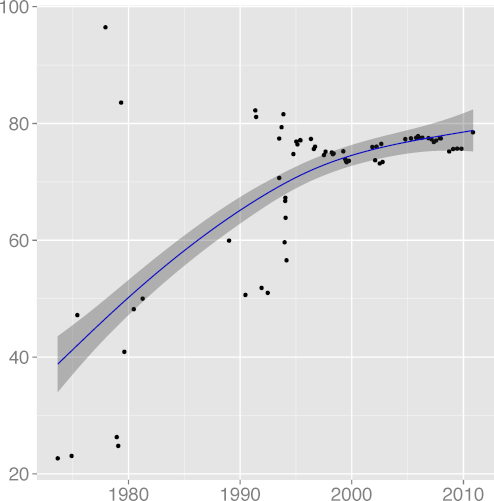 CMCHAR 0.48 |  DCMCHAR 0.70 | 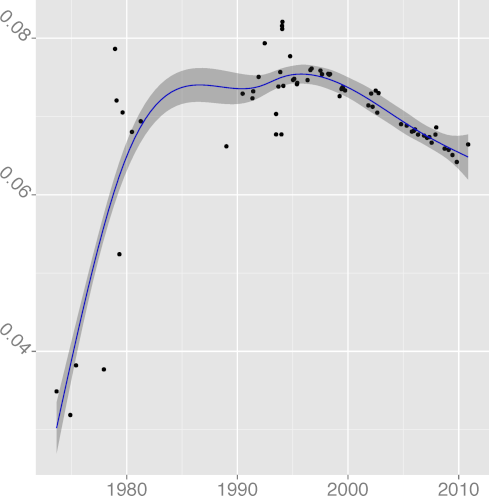 DCM 0.77 |  DCONST 0.98 | 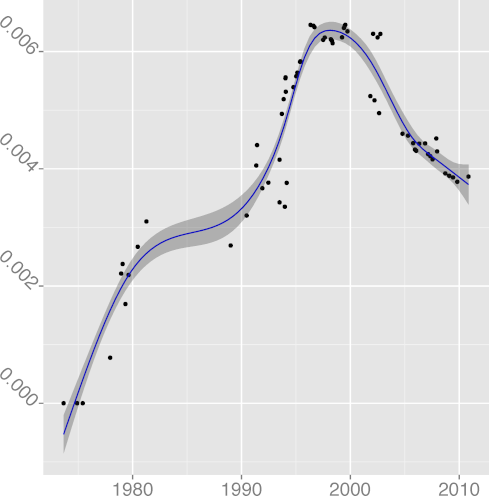 DCPIF 0.92 |
 DCPINC 0.37 |  DCPSTMT 0.78 | 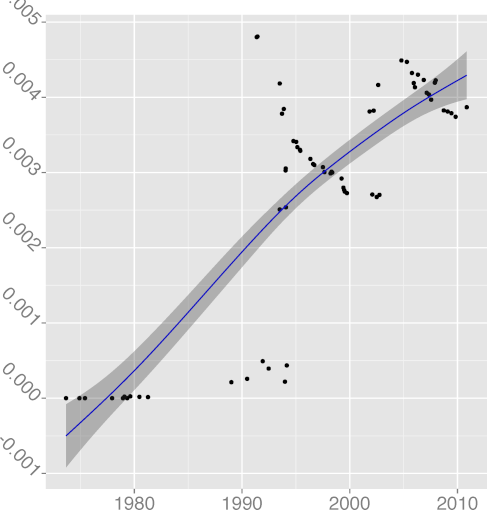 DENUM 0.66 | 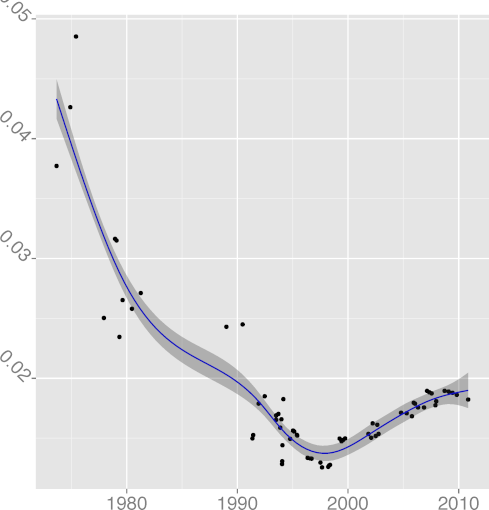 DGOTO 0.88 | 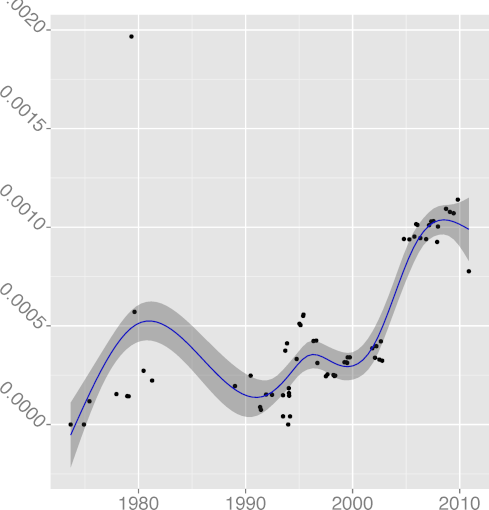 DINL 0.64 |
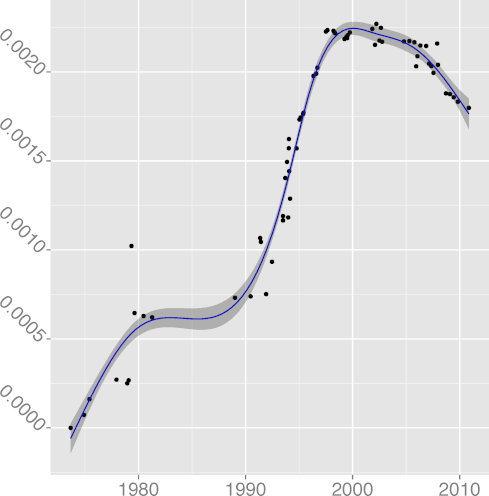 DKLUDGE 0.97 | 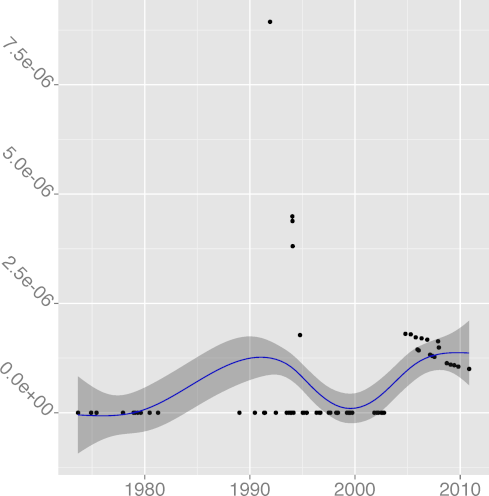 DNOAL 0.12 | 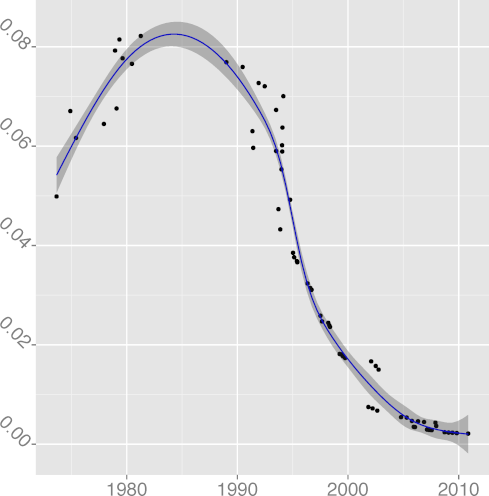 DREG 0.97 | 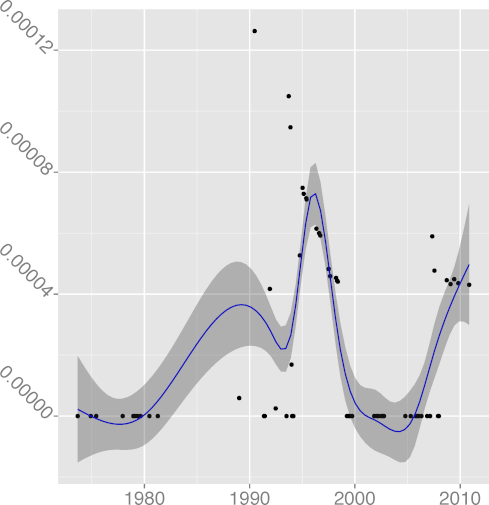 DREST 0.39 | 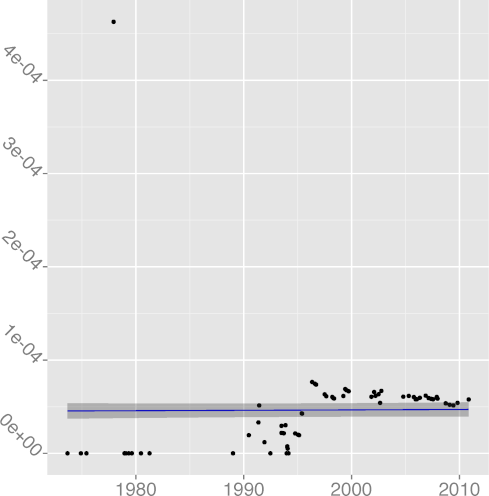 DSIGN 0.00 |
 DSTATIC 0.97 |  DSTMT 0.84 | 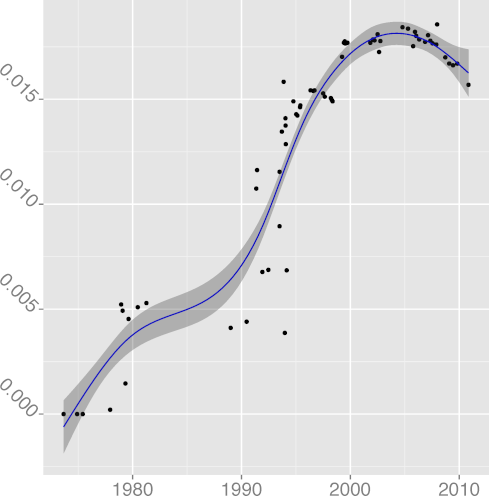 DUNS 0.89 | 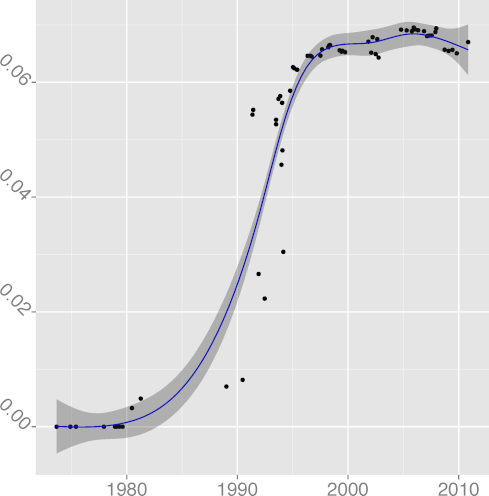 DVOID 0.92 | 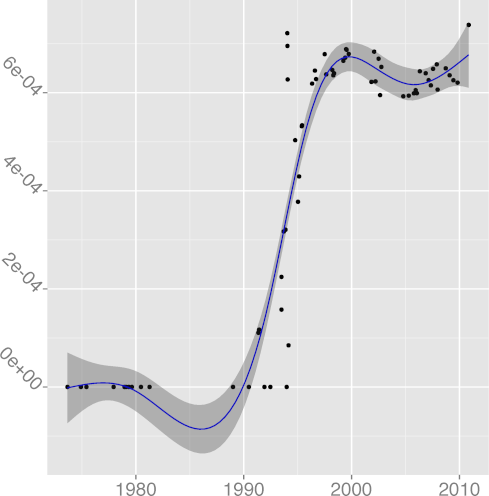 DVOL 0.86 |
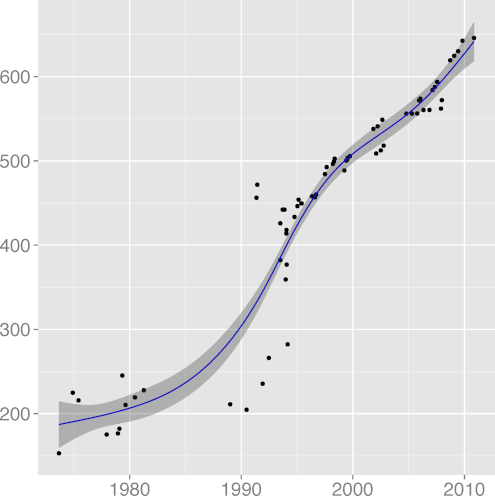 FILINE 0.91 | 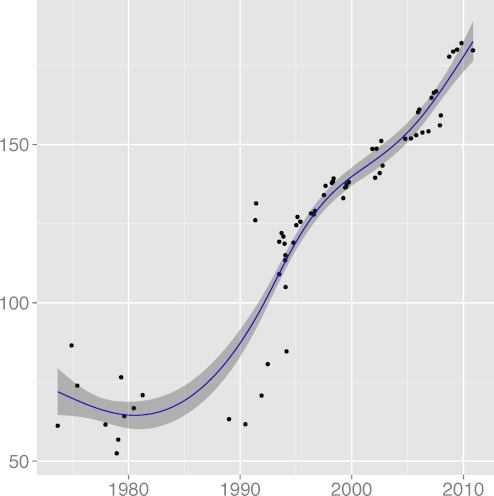 FISTMT 0.90 | 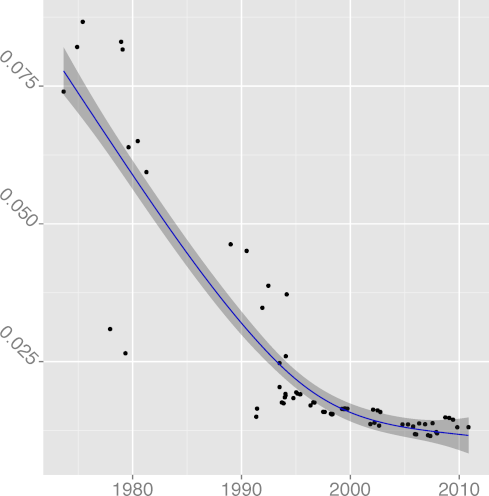 FMINC 0.81 |  FULINE 0.91 |  IDCHAR 0.94 |
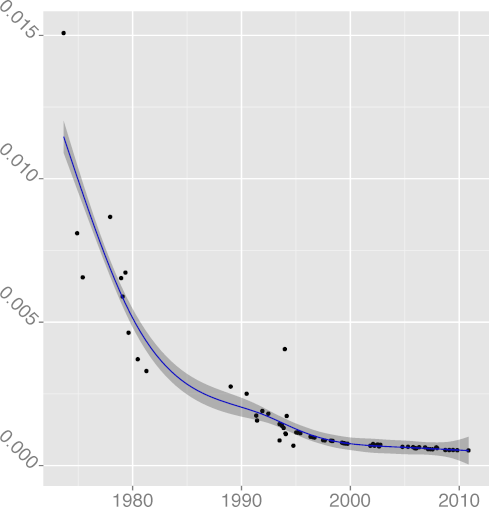 INDEV 0.89 | 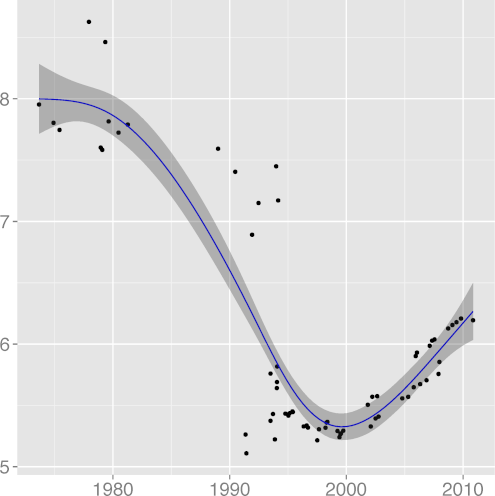 INSPC 0.77 | 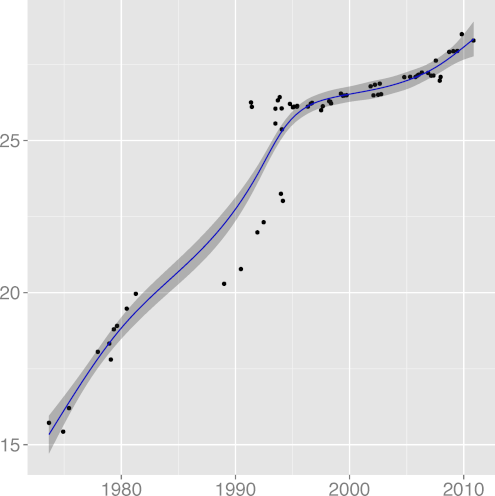 LICHAR 0.93 | 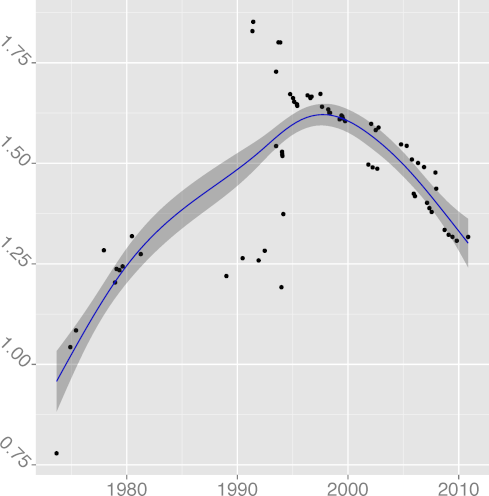 STNEST 0.64 |
Figure 2: Long term evolution of programming practices.
(Metrics appear in alphabetical order;
the number following the metric name is adjusted R2.)
H3: New language features are increasingly used to saturation point
The metrics
DCONST, const keyword density
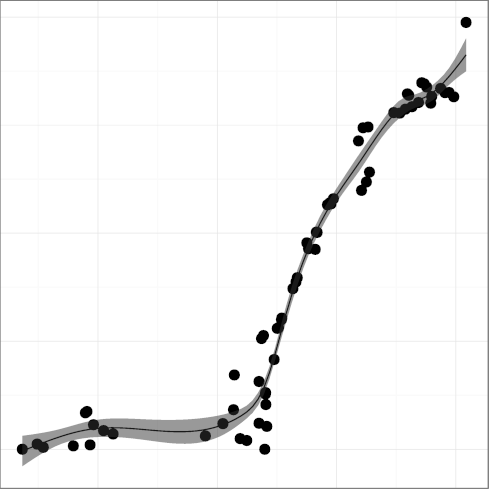 (R2 = 0.97);
DENUM, enum keyword density
(R2 = 0.97);
DENUM, enum keyword density
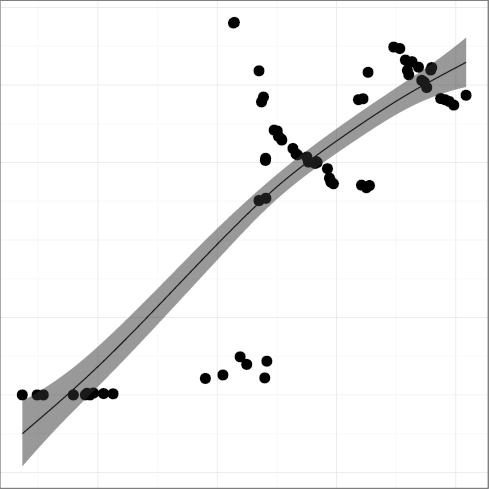 (R2 = 0.66);
DINL, inline keyword density
(R2 = 0.66);
DINL, inline keyword density
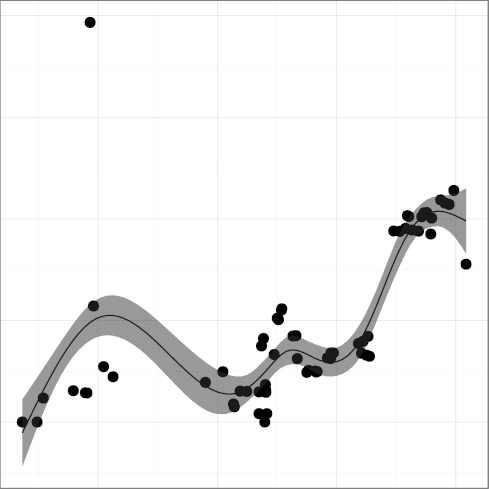 (R2 = 0.64);
DUNS, unsigned keyword density
(R2 = 0.64);
DUNS, unsigned keyword density
 (R2 = 0.89);
DVOID, void keyword density
(R2 = 0.89);
DVOID, void keyword density
 (R2 = 0.93);
and DVOL, volatile keyword density
(R2 = 0.93);
and DVOL, volatile keyword density
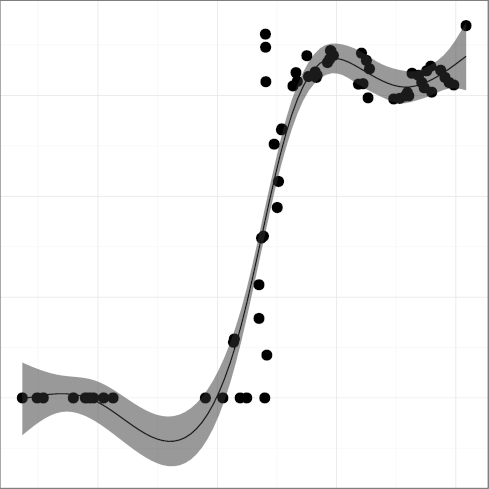 (R2 = 0.86), have in general climbed up over time.
The overall upward trend of enum and inline
is overlayed on partial downward trends, resulting in a low R2 figure.
One could hypothesize that developers switch between enthusiasm and
indifference regarding their use.
The DUNS metric seems to have retreated over the past few years.
The reduced use could be attributed to two factors.
The first may be the introduction of the size_t
keyword in the 1999 ISO C standard [23].
This represents more descriptively the size of memory objects.
For example, the argument to the malloc C library function
is unsigned in 4.3BSD but
is size_t in 4.4BSD.
The second may have to do with the application of the
unsigned keyword on integral data
types to double the range of (positive) numbers they could hold.
The introduction of 64-bit architectures and increases in memory capacity,
which provide an integral data type that can hold numbers of up 1019
and sufficient memory space for its use,
may have obsoleted this practice.
Consequently, new code has fewer reasons to use the unsigned
keyword, resulting in a relative decline of it use.
The metrics
DNOAL, noalias keyword density,
(R2 = 0.86), have in general climbed up over time.
The overall upward trend of enum and inline
is overlayed on partial downward trends, resulting in a low R2 figure.
One could hypothesize that developers switch between enthusiasm and
indifference regarding their use.
The DUNS metric seems to have retreated over the past few years.
The reduced use could be attributed to two factors.
The first may be the introduction of the size_t
keyword in the 1999 ISO C standard [23].
This represents more descriptively the size of memory objects.
For example, the argument to the malloc C library function
is unsigned in 4.3BSD but
is size_t in 4.4BSD.
The second may have to do with the application of the
unsigned keyword on integral data
types to double the range of (positive) numbers they could hold.
The introduction of 64-bit architectures and increases in memory capacity,
which provide an integral data type that can hold numbers of up 1019
and sufficient memory space for its use,
may have obsoleted this practice.
Consequently, new code has fewer reasons to use the unsigned
keyword, resulting in a relative decline of it use.
The metrics
DNOAL, noalias keyword density,
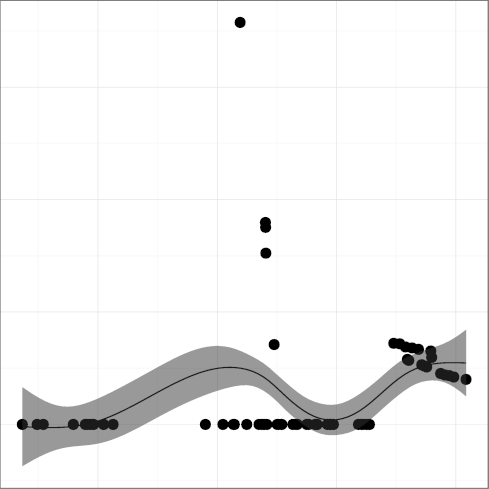 (R2 = 0.12)
and DSIGN, signed keyword density,
(R2 = 0.12)
and DSIGN, signed keyword density,
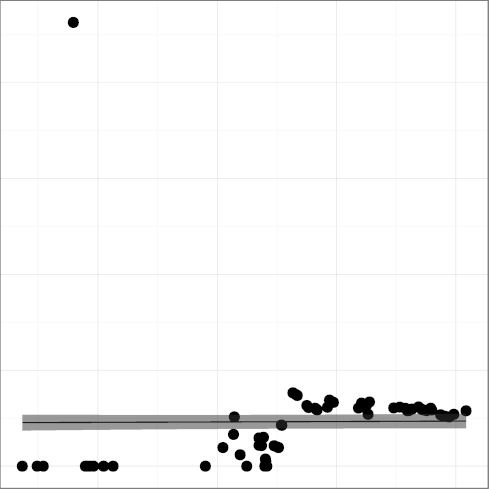 (R2 = 0.04),
seem impervious to time, consistent with a lacklustre adoption.
The signed keyword is mostly useful in cases one wants
to store a signed value in a char-typed variable.
Given current memory alignment restrictions and sizes,
such a choice is nowadays both expensive and unnecessary.
The rise of noalias appearances after the year 2000 is due to
the use of noalias as a plain identifier,
after the name had clearly lost its keyword status.
The metric
DREST, restrict keyword density,
(R2 = 0.04),
seem impervious to time, consistent with a lacklustre adoption.
The signed keyword is mostly useful in cases one wants
to store a signed value in a char-typed variable.
Given current memory alignment restrictions and sizes,
such a choice is nowadays both expensive and unnecessary.
The rise of noalias appearances after the year 2000 is due to
the use of noalias as a plain identifier,
after the name had clearly lost its keyword status.
The metric
DREST, restrict keyword density,
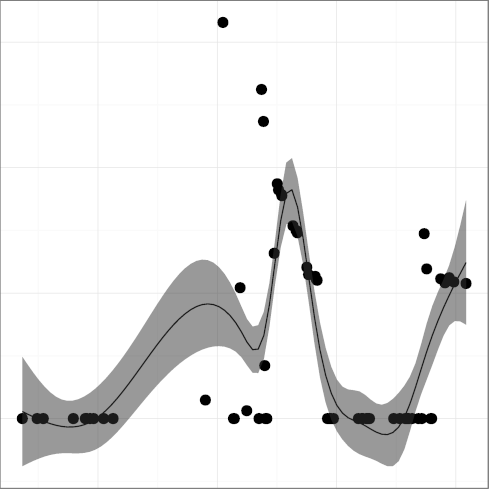 (R2 = 0.39),
could have shown an upward trend and a higher R2 were it not
for the fact that during the period 1999-2007 it was defined and used
as __restrict so that the code could easily work with
compilers that did not support it.
The hypothesis is therefore validated with the proviso that the
newly introduced language feature is widely useful to the programming
community; if it is, its use will increase until it plateaus,
presumably having reached a saturation point. The DNOAL and
dsign metrics provide support to an alternative hypothesis: that
language features are not adopted, presumably because they do not
correspond to an important need.
As Dennis Ritchie wrote to the X3J11 C standardization committee,
language keywords should carry their weight;
it is a mistake having keywords that
"what they add to the cost of learning and using the language
is not repaid in greater expressiveness" [44].
This finding indicates the importance of investing in sound language evolution.
This is something that the C++, Fortran, and Java communities seem to have
handled in a competent way,
while the Python and Perl communities have mismanaged or neglected.
Also languages such as C and Lisp may have reached their limits of significant evolution.
It would therefore be interesting to investigate what effect the stewardship of
language evolution has on a language's adoption and use.
H4: Programmers trust the compiler for register allocation
The metric
DREG, register keyword density
(R2 = 0.39),
could have shown an upward trend and a higher R2 were it not
for the fact that during the period 1999-2007 it was defined and used
as __restrict so that the code could easily work with
compilers that did not support it.
The hypothesis is therefore validated with the proviso that the
newly introduced language feature is widely useful to the programming
community; if it is, its use will increase until it plateaus,
presumably having reached a saturation point. The DNOAL and
dsign metrics provide support to an alternative hypothesis: that
language features are not adopted, presumably because they do not
correspond to an important need.
As Dennis Ritchie wrote to the X3J11 C standardization committee,
language keywords should carry their weight;
it is a mistake having keywords that
"what they add to the cost of learning and using the language
is not repaid in greater expressiveness" [44].
This finding indicates the importance of investing in sound language evolution.
This is something that the C++, Fortran, and Java communities seem to have
handled in a competent way,
while the Python and Perl communities have mismanaged or neglected.
Also languages such as C and Lisp may have reached their limits of significant evolution.
It would therefore be interesting to investigate what effect the stewardship of
language evolution has on a language's adoption and use.
H4: Programmers trust the compiler for register allocation
The metric
DREG, register keyword density
 (R2 = 0.96),
has been steadily declining
from around 1990. This may have been the point when compiler
technology advanced sufficiently and developers really started
trusting that the compiler would do a better job at register
allocation than they could.
At some point compilers began to ignore register declarations,
forcibly taking over the task of register allocation.
It seems that programmers are eager to
slough off responsibility when they can afford to.
Actions associated with this hypothesis would be investment and research
in technologies that can assist developers in a similar way.
The characteristics we are looking at are
minimal (ideally zero) involvement of the programmer,
at least modest gains, and
a very low downside risk.
Obvious areas for such investment include
static analysis to locate bugs,
resource management,
the utilization of multiple computing cores,
optimization of cache and memory access patterns, and
reduction of energy use.
H5: Code formatting practices converge to a common standard
The metrics
FMINC, formatting inconsistency
(R2 = 0.96),
has been steadily declining
from around 1990. This may have been the point when compiler
technology advanced sufficiently and developers really started
trusting that the compiler would do a better job at register
allocation than they could.
At some point compilers began to ignore register declarations,
forcibly taking over the task of register allocation.
It seems that programmers are eager to
slough off responsibility when they can afford to.
Actions associated with this hypothesis would be investment and research
in technologies that can assist developers in a similar way.
The characteristics we are looking at are
minimal (ideally zero) involvement of the programmer,
at least modest gains, and
a very low downside risk.
Obvious areas for such investment include
static analysis to locate bugs,
resource management,
the utilization of multiple computing cores,
optimization of cache and memory access patterns, and
reduction of energy use.
H5: Code formatting practices converge to a common standard
The metrics
FMINC, formatting inconsistency
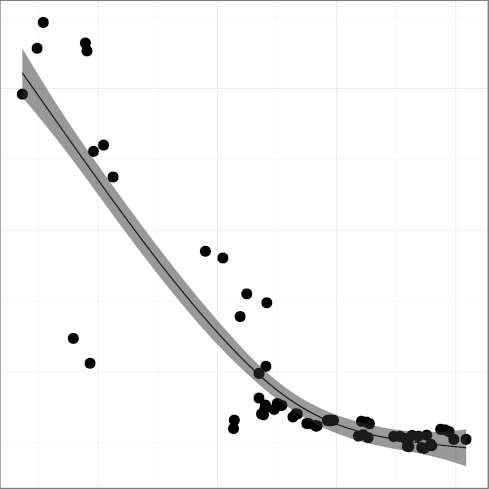 (R2 = 0.81),
and INDEV, indentation spaces standard deviation
(R2 = 0.81),
and INDEV, indentation spaces standard deviation
 (R2 = 0.89),
have both been falling over time, providing strong support to the hypothesis
that code formatting practices do converge, reducing inconsistencies
and evolving towards a more homogeneous style.
Our findings seem to show an instance where an online community has
successfully driven consensus and adoption of common practices.
Research could examine drivers for other desirable trends, such as
software security, unit testing, and operations support.
H6: Software complexity evolution follows self correction
feedback mechanisms
The metrics
FULINE, mean function length,
(R2 = 0.89),
have both been falling over time, providing strong support to the hypothesis
that code formatting practices do converge, reducing inconsistencies
and evolving towards a more homogeneous style.
Our findings seem to show an instance where an online community has
successfully driven consensus and adoption of common practices.
Research could examine drivers for other desirable trends, such as
software security, unit testing, and operations support.
H6: Software complexity evolution follows self correction
feedback mechanisms
The metrics
FULINE, mean function length,
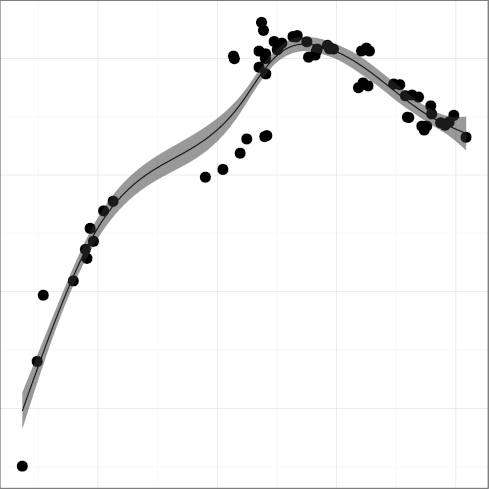 (R2 = 0.91);
STNEST, mean statement nesting,
(R2 = 0.91);
STNEST, mean statement nesting,
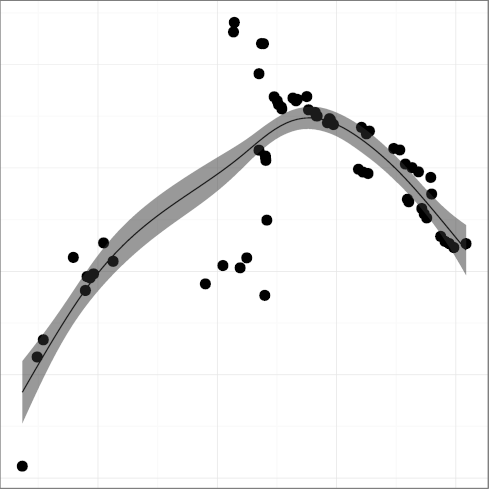 (R2 = 0.64);
DCPIF, C preprocessor conditional statement density
(R2 = 0.64);
DCPIF, C preprocessor conditional statement density
 (R2 = 0.92);
DCPSTMT, C preprocessor non-include statement density
(R2 = 0.92);
DCPSTMT, C preprocessor non-include statement density
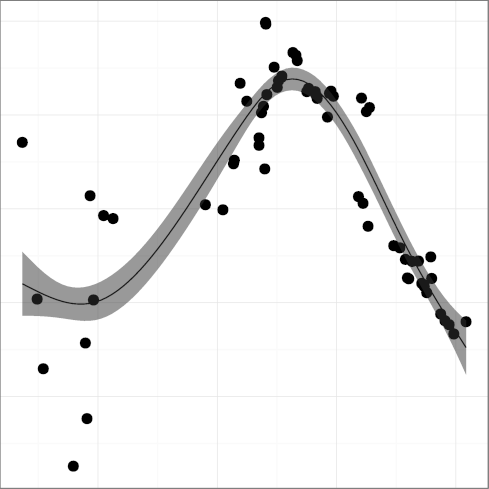 (R2 = 0.87),
all seem to follow a pattern where the metric grows indicating greater
complexity, until a reverse trend kicks in and complexity starts
falling.
For example, FULINE and STNEST may have increased due to
new ergonomic affordances (more lines can fit on a display),
but their increase may have overreached regarding the programmers' capacity
to comprehend the corresponding code.
That is consistent with a view of software complexity
evolution being guided through self correcting feedback. Perhaps
controversially, the same can be argued for the evolution of
DGOTO, goto keyword density
(R2 = 0.87),
all seem to follow a pattern where the metric grows indicating greater
complexity, until a reverse trend kicks in and complexity starts
falling.
For example, FULINE and STNEST may have increased due to
new ergonomic affordances (more lines can fit on a display),
but their increase may have overreached regarding the programmers' capacity
to comprehend the corresponding code.
That is consistent with a view of software complexity
evolution being guided through self correcting feedback. Perhaps
controversially, the same can be argued for the evolution of
DGOTO, goto keyword density
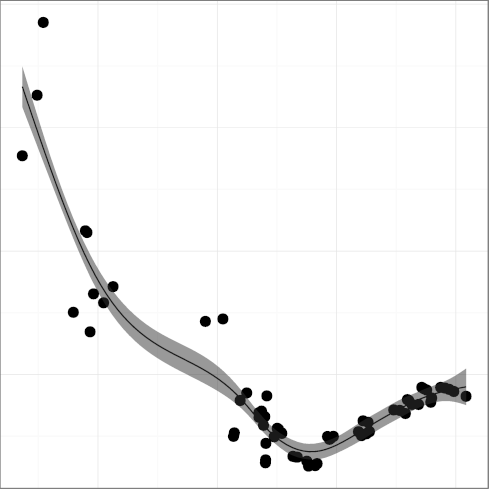 (R2 = 0.88), whose value has started increasing after a long
declining trend. It seems that programmers are loath to give up a
maligned language construct, despite half a century of drilling
against it. Perhaps goto is too valuable to let go; or
letting it go results in code that is more complex than simply using
it judiciously.
Our findings here are in agreement with several of Lehman's laws of
software evolution [29], namely:
Increasing Complexity,
Conservation of Familiarity,
Declining Quality, and
Feedback System.
The corresponding consequences of these laws have been investigated
for many years [21],
so we will not attempt to expand on this topic here.
H7: Code readability increases
We would expect code readability to increase until reaching a plateau,
consistently with all programming advice. As proxies for code
readability we have
INSPC, mean indentation spaces
(R2 = 0.88), whose value has started increasing after a long
declining trend. It seems that programmers are loath to give up a
maligned language construct, despite half a century of drilling
against it. Perhaps goto is too valuable to let go; or
letting it go results in code that is more complex than simply using
it judiciously.
Our findings here are in agreement with several of Lehman's laws of
software evolution [29], namely:
Increasing Complexity,
Conservation of Familiarity,
Declining Quality, and
Feedback System.
The corresponding consequences of these laws have been investigated
for many years [21],
so we will not attempt to expand on this topic here.
H7: Code readability increases
We would expect code readability to increase until reaching a plateau,
consistently with all programming advice. As proxies for code
readability we have
INSPC, mean indentation spaces
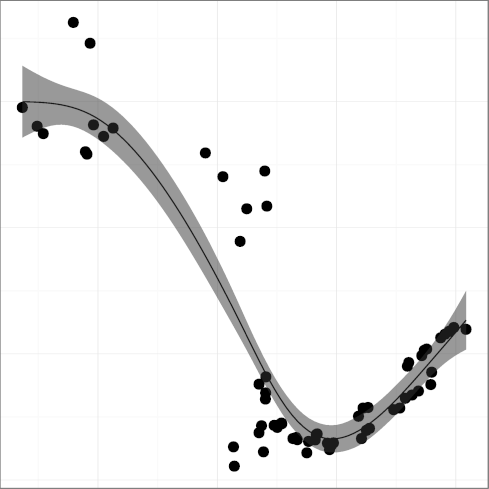 (R2 = 0.77);
DSTMT, statement density
(R2 = 0.77);
DSTMT, statement density
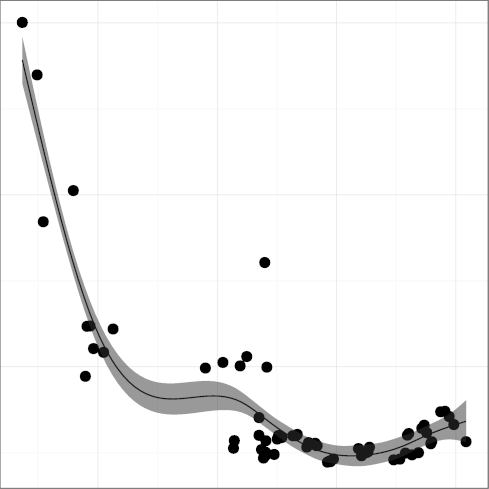 (R2 = 0.84);
DCMCHAR, comment character density
(R2 = 0.84);
DCMCHAR, comment character density
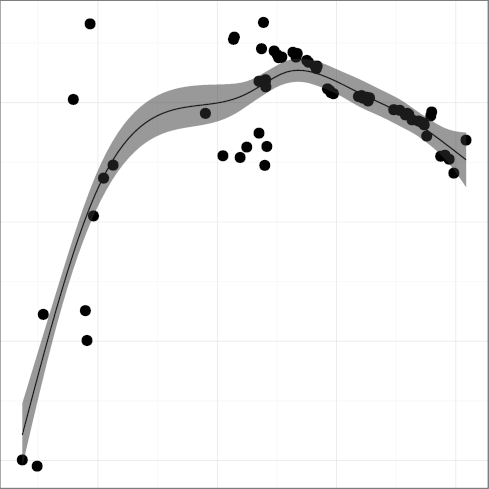 (R2 = 0.70);
CMCHAR, mean comment size
(R2 = 0.70);
CMCHAR, mean comment size
 (R2 = 0.48);
DCM, comment density
(R2 = 0.48);
DCM, comment density
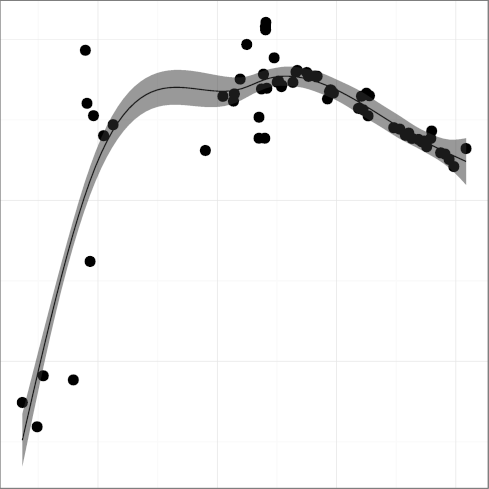 (R2 = 0.77);
DKLUDGE, kludge word density
(R2 = 0.77);
DKLUDGE, kludge word density
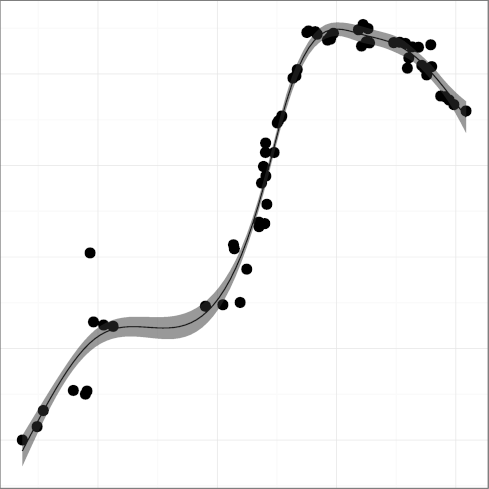 (R2 = 0.97).
Taken together, the metrics present a mixed,
though mostly positive, picture.
Comment density and comment character density follow a pattern where important
improvements have started losing some ground.
This could be related to the adoption of longer identifiers, which may
make code more self-documenting.
Statement density followed a
consistent downwards trend, which is good, until well into the 2000s
when it started edging upwards, which is worrying.
The density of words indicating substandard code in comments
has only recently started declining.
The amount of whitespace used for indentation seems to be converging
at or below the six spaces considered to be the point above which
readability suffers.
These metrics show that Unix code readability has improved
significantly over the early years.
However, they do not provide evidence that readability is still increasing.
The future will tell us whether we are currently witnessing a
regression toward the mean that corrects excessibe adherance to
readability guidelines,
or whether developers have lost interest in these mechanical
aspects of readability.
Our failure to support this hypothesis may well indicate the limits on how far
internal code quality can be improved through commenting, and, in general,
the diminishing returns of investing in the code's documentary structure [60].
Consequently, research has to be directed into other areas that can
drive internal code quality.
Examples include
more powerful programming structures,
refactoring,
specialized libraries,
model-driven development,
meta-programming,
domain-specific languages,
static analysis, and
online collaboration platforms.
(R2 = 0.97).
Taken together, the metrics present a mixed,
though mostly positive, picture.
Comment density and comment character density follow a pattern where important
improvements have started losing some ground.
This could be related to the adoption of longer identifiers, which may
make code more self-documenting.
Statement density followed a
consistent downwards trend, which is good, until well into the 2000s
when it started edging upwards, which is worrying.
The density of words indicating substandard code in comments
has only recently started declining.
The amount of whitespace used for indentation seems to be converging
at or below the six spaces considered to be the point above which
readability suffers.
These metrics show that Unix code readability has improved
significantly over the early years.
However, they do not provide evidence that readability is still increasing.
The future will tell us whether we are currently witnessing a
regression toward the mean that corrects excessibe adherance to
readability guidelines,
or whether developers have lost interest in these mechanical
aspects of readability.
Our failure to support this hypothesis may well indicate the limits on how far
internal code quality can be improved through commenting, and, in general,
the diminishing returns of investing in the code's documentary structure [60].
Consequently, research has to be directed into other areas that can
drive internal code quality.
Examples include
more powerful programming structures,
refactoring,
specialized libraries,
model-driven development,
meta-programming,
domain-specific languages,
static analysis, and
online collaboration platforms.
File translated from TEX by TTH, version 4.03.
On 21 May 2016, 03:43.
4 Related Work
Work related to the study of the long term evolution of programming practices can be divided into that associated with software evolution, that looking at the actual programming practices, and that associated with our specific hypotheses. The evolution of software has been the subject of decades of research [10]. A central theoretical underpinning regarding software's evolution are Lehman's eponymous laws as initially stated [27] and subsequently revised and extended [28,30,29]. We will not expand on the topic, because a recent extensive survey of it [21] provides an excellent historical overview and discusses the current state of the art. Along similar lines, a number of important studies focus on the stages of software growth [31,6,59], as well as software ageing [40] or decay [14]. One study particularly relevant to our work [1] examined how the vocabulary used in two software projects evolved over five and eight software versions respectively. The researchers found that identifiers faced the same evolution pressures as code. A related study [47] examined the changes in code convention violations in four open source projects. The authors report that code size and associated violations appear to grow together in a 100-commit window. Two studies have looked at the evolution of commenting practices over time: one [24] examined ProsgreSQL from 1996 to 2005, and one [19] Linux from 1994 to 1999. Both studies found comments to have remained roughly constant over time. The second study [19] also observed an increase in the size of the files. Compared to the preceding studies, our work examines a wider variety of metrics over a significantly longer time scale. On the subject of programming practices McConnel's Code Complete [36] contains a full chapter (11) discussing the naming of variable names, and one (chapter 31) discussing code layout and style. Style guidelines can also be found in references [26,17,9,56,61,55,38,22]. An interesting theoretical contribution on this front has been made by Van De Vanter [60], who has argued that all extralingual information added by programmers for aiding the human reader forms the code's documentary structure, which is orthogonal to the linguistic elements used by the compiler. A substantial body of work has been performed on the subject of our hypotheses, though not on the long timescale we examined. Here we summarize the most important papers. Regarding H1 (Programming practices reflect technology affordances) Leonardi [32] argues that the imbrication metaphor (between human and material agencies) can help us to explain how the social and the material become interwoven and continue to produce improved infrastructures that people use to get their work done. On the subject of H2 (Modularity increases with code size) Capiluppi et al. [11] found that - as one could expect - modularity is related to code size. They state that as a project grows, developers reorganize code adding new modules. Concerning H3 (New language features are increasingly used to saturation point) Parnin et al. [41] explored how Java developers use new language features regarding generics. Interestingly, they found that developers may not replace old code with new language features, meaning that only the introduction of a new language feature is not enough to ensure adoption. On the topic of H4 (Programmers trust the compiler for register allocation) Arnold [4] also found that the register keyword quickly became advisory, and that now all C/C++ compilers just ignore it. Regarding H5 (Code formatting practices converge to a common standard) according to an empirical study conducted by Bacchelli and Bird at Microsoft [5], one of the most important tasks of code reviewers is to check if the code follows the team standards and conventions in terms of code formatting and in terms of function and variable naming. On the topic of H6 (Software complexity evolution follows self correction feedback mechanisms) Terceiro et al. [58] also agree that system growth is not necessarily associated with structural complexity increases. Finally, as far as H7 (Code readability increases) is concerned Buse and Weimer [7] propose a learning metric for code readability, which correlates strongly with three measures of software quality: code changes, automated defect reports, and defect log messages. Their study suggests that comments, in and of themselves, are less important than simple blank lines to local judgments of readability.5 Conclusions and Further Work
We started this paper writing that tracking long-term progress in a discipline allows us to take stock of things we have achieved, appreciate the factors that led to them, and set realistic goals for where we want to go. The results we obtained by examining the evolution of the Unix source code over a period of more than four decades paint a corresponding broad brush picture. Over the years the developers of the Unix operating system appear to have: evolved their code style in tandem with advancements in hardware technology, promoted modularity to tame rising complexity, adopted valuable new language features, allowed compilers to allocate registers on their behalf, and reached broad agreement regarding code formatting. Our findings have also shown two other processes at play, namely self correcting feedback mechanisms associated with rising software complexity and documentary code structure improvements that have reached a ceiling. The interplay between increased complexity, on the one hand, and technological affordances, on the other, may explain some of the inflection points we have witnessed. For example, technology has allowed developers to work with longer functions with ease, but longer functions are also more complex than shorter ones. We can speculate that when complexity trumped technology developers backed down and reverted to writing shorter, simpler functions. Time will show whether there will be another reversal in the future, with developers opting once more for more complexity. If so, a mechanism similar to that of other dynamical systems describing opposing and interactive forces may lurk behind the phenomenon. Although we do not claim to have proven a causal relationship, it is plausible that the trends we observed are related to advances in tools, languages, ergonomics, guidelines, processing power, and conventions. So, even though we have not proposed an underlying model by which such advances translate to the changes in metrics we have observed, we believe it is very unlikely that they have not had an impact on software development. Further investments in tools, languages, and ergonomics are likely to be progress drivers. On the other hand, further returns on investment in programming guidelines and conventions are unlikely to match those of the past. The structure and forces of the IT market guarantee that additional processing power is likely to reach developers without requiring significant interventions. The fact that some metrics have retreated or reached a plateau indicates that this is no longer enough to increase quality further. In addition, the looming end of progress in semiconductor manufacturing driven by Moore's Law [35] means that corresponding advancement of software development practices based on its fruits will also stall; we will need to come up with other, more frugal or different, sources of innovation. Social coding, as performed on GitHub, and cloud computing come to mind, but other new ways to drive progress surely remain to be discovered. The study of long term programming practice evolution can be expanded on a number of fronts. An important task, to which we alluded above, would be to examine and establish causality regarding the factors affecting the trends. This could be helped by performing regression with the underlying factor (e.g., screen resolution) rather than time as the independent variable. Based on these results one could then perform meaningful cost-benefit analysis regarding investments in software development infrastructure. Moreover, the accuracy of the analysis can be improved by studying a period's specific code changes, rather than complete snapshots, which mostly incorporate legacy code. This could be done by employing qualitative rather than quantitative methods. Such a study could also provide insights regarding the various inflection points we observed in the 1990s and early 2000s. Are these inflections the result of reaching (after several decades) a limit regarding complexity and therefore regressing to the mean, or did the change involve a catalyst? Furthermore, in addition to code, it would also be valuable to perform a quantitative examination of other process-related inputs, such as configuration management entries, the issues' lifecycle, and team collaborations. Finally, many more systems should be studied in order to validate the generalisability of our results.Acknowledgements
John Pagonis provided a number of insightful comments on earlier versions of this document. This research has been co-financed by the European Union (European Social Fund - ESF) and Greek national funds through the Operational Program "Education and Lifelong Learning" of the National Strategic Reference Framework (NSRF) - Research Funding Program: Thalis - Athens University of Economics and Business - Software Engineering Research Platform.References
- [1]
- S. Abebe, S. Haiduc, A. Marcus, P. Tonella, and G. Antoniol. Analyzing the evolution of the source code vocabulary. In CSMR '09: 13th European Conference on Software Maintenance and Reengineering, pages 189-198, March 2009.
- [2]
- American National Standard for Information Systems - programming language - C: ANSI X3.159-1989, Dec. 1989. (Also ISO/IEC 9899:1990).
- [3]
- O. Arafat and D. Riehle. The commenting practice of open source. In OOPSLA '09: 24th ACM SIGPLAN Conference Companion on Object Oriented Programming Systems Languages and Applications, pages 857-864, New York, NY, USA, 2009. ACM.
- [4]
- K. Arnold. Programmers are people, too. Queue, 3(5):54-59, June 2005.
- [5]
- A. Bacchelli and C. Bird. Expectations, outcomes, and challenges of modern code review. In ICSE '13: 35th International Conference on Software Engineering, pages 712-721, Piscataway, NJ, USA, 2013. IEEE Press.
- [6]
- K. H. Bennett and V. T. Rajlich. Software maintenance and evolution: A roadmap. In Conference on The Future of Software Engineering, pages 73-87, New York, NY, USA, 2000. ACM.
- [7]
- R. Buse and W. Weimer. Learning a metric for code readability. IEEE Transactions on Software Engineering, 36(4):546-558, July 2010.
- [8]
- S. Butler, M. Wermelinger, Y. Yu, and H. Sharp. Exploring the influence of identifier names on code quality: An empirical study. In CSMR '10: 14th European Conference on Software Maintenance and Reengineering, pages 156-165, March 2010.
- [9]
- L. W. Cannon, R. A. Elliott, L. W. Kirchhoff, J. H. Miller, J. M. Milner, R. W. Mitze, E. P. Schan, N. O. Whittington, H. Spencer, D. Keppel, and M. Brader. Recommended C style and coding standards. Available online http://sunland.gsfc.nasa.gov/info/cstyle.html (January 2006). Updated version of the Indian Hill C Style and Coding Standards paper.
- [10]
- A. Capiluppi. Models for the evolution of OS projects. In ICSM '03: International Conference on Software Maintenance, pages 65-74, 2003.
- [11]
- A. Capiluppi, P. Lago, and M. Morisio. Characteristics of open source projects. In 7th European Conference on Software Maintenance and Reengineering, pages 317-327, March 2003.
- [12]
- G. J. Chaitin. Register allocation & spilling via graph coloring. SIGPLAN Notices, 17(6):98-101, June 1982.
- [13]
- E. W. Dijkstra. Go to statement considered harmful. Communications of the ACM, 11(3):147-148, Mar. 1968.
- [14]
- S. G. Eick, T. L. Graves, A. F. Karr, J. S. Marron, and A. Mockus. Does code decay? Assessing the evidence from change management data. IEEE Transactions on Software Engineering, 27(1):1-12, Jan. 2001.
- [15]
- M. D. Ernst, G. J. Badros, and D. Notkin. An empirical analysis of C preprocessor use. IEEE Transactions on Software Engineering, 28(12):1146-1170, Dec. 2002.
- [16]
- B. Fluri, M. Wursch, and H. Gall. Do code and comments co-evolve? On the relation between source code and comment changes. In WCRE 2007: 14th Working Conference on Reverse Engineering, pages 70-79, Oct 2007.
- [17]
- The FreeBSD Project. Style-Kernel Source File Style Guide, Dec. 1995. FreeBSD Kernel Developer's Manual: style(9). Available online http://www.freebsd.org/docs.html (January 2006).
- [18]
- P. Gazzillo and R. Grimm. SuperC: Parsing all of C by taming the preprocessor. In PLDI '12: Programming Language Design and Implementation, pages 323-334, 2012.
- [19]
- M. Godfrey and Q. Tu. Evolution in open source software: A case study. In CSMR '00: International Conference on Software Maintenance, pages 131-142, 2000.
- [20]
- G. Gousios and D. Spinellis. Conducting quantitative software engineering studies with Alitheia Core. Empirical Software Engineering, 19(4):885-925, Aug. 2014.
- [21]
- I. Herraiz, D. Rodriguez, G. Robles, and J. M. González-Barahona. The evolution of the laws of software evolution: A discussion based on a systematic literature review. ACM Computing Surveys, 46(2), Nov. 2013.
- [22]
- G. Holzmann. The power of 10: rules for developing safety-critical code. Computer, 39(6):95-99, June 2006.
- [23]
- International Organization for Standardization. Programming Languages - C. ISO, Geneva, Switzerland, 1999. ISO/IEC 9899:1999.
- [24]
- Z. M. Jiang and A. E. Hassan. Examining the evolution of code comments in PostgreSQL. In MSR '06: 2006 International Workshop on Mining Software Repositories, pages 179-180, New York, NY, USA, 2006. ACM.
- [25]
- S. H. Kan. Metrics and Models in Software Quality Engineering. Addison-Wesley, Boston, MA, second edition, 2002.
- [26]
- B. W. Kernighan and P. J. Plauger. The Elements of Programming Style. McGraw-Hill, New York, second edition, 1978.
- [27]
- M. Lehman. On understanding laws, evolution, and conservation in the large-program life cycle. Journal of Systems and Software, 1:213-221, 1979.
- [28]
- M. M. Lehman and L. A. Belady. Program Evolution: Processes of Software Change. Academic Press, 1985.
- [29]
- M. M. Lehman and J. F. Ramil. Rules and tools for software evolution planning and management. Annals of Software Engineering, 11(1):15-44, 2001.
- [30]
- M. M. Lehman, J. F. Ramil, P. D. Wernick, D. E. Perry, and W. M. Turski. Metrics and laws of software evolution - the nineties view. In METRICS '97: 4th International Symposium on Software Metrics, pages 20-32, Washington, DC, USA, 1997. IEEE Computer Society.
- [31]
- F. Lehner. Software life cycle management based on a phase distinction method. Microprocessing and Microprogramming, 32(1OCo5):603 - 608, 1991. Euromicro symposium on microprocessing and microprogramming.
- [32]
- P. M. Leonardi. When flexible routines meet flexible technologies: Affordance, constraint, and the imbrication of human and material agencies. MIS Quarterly, 35(1):147-168, Mar. 2011.
- [33]
- J. Liebig, C. Kästner, and S. Apel. Analyzing the discipline of preprocessor annotations in 30 million lines of C code. In AOSD '11: 10th International Conference on Aspect-Oriented Software Development, pages 191-202, 2011.
- [34]
- P. E. Livadas and D. T. Small. Understanding code containing preprocessor constructs. In IEEE Third Workshop on Program Comprehension, pages 89-97, Nov. 1994.
- [35]
- C. Mack. Fifty years of Moore's law. IEEE Transactions on Semiconductor Manufacturing, 24(2):202-207, May 2011.
- [36]
- S. C. McConnell. Code Complete: A Practical Handbook of Software Construction. Microsoft Press, Redmond, WA, second edition, 2004.
- [37]
- R. J. Miara, J. A. Musselman, J. A. Navarro, and B. Shneiderman. Program indentation and comprehensibility. Communications of the ACM, 26(11):861-867, Nov. 1983.
- [38]
- T. Misfeldt, G. Bumgardner, and A. Gray. The Elements of C++ Style. Cambridge University Press, Cambridge, 2004.
- [39]
- A. Mockus. Amassing and indexing a large sample of version control systems: Towards the census of public source code history. In MSR '09: 6th IEEE International Working Conference on Mining Software Repositories, pages 11-20, Washington, DC, USA, 2009. IEEE Computer Society.
- [40]
- D. L. Parnas. Software aging. In ICSE '94: 16th International Conference on Software Engineering, pages 279-287, Washington, DC, May 1994. IEEE Computer Society.
- [41]
- C. Parnin, C. Bird, and E. Murphy-Hill. Java generics adoption: How new features are introduced, championed, or ignored. In MSR '11: 8th Working Conference on Mining Software Repositories, pages 3-12, New York, NY, USA, 2011. ACM.
- [42]
- D. Posnett, A. Hindle, and P. Devanbu. A simpler model of software readability. In MSR '11: 8th Working Conference on Mining Software Repositories, pages 73-82, New York, NY, USA, 2011. ACM.
- [43]
- E. S. Raymond. The Art of Unix Programming. Addison-Wesley, 2003.
- [44]
- D. M. Ritchie. noalias comments to X3J11. Usenet Newsgroup comp.lang.c, Mar. 1988. Message-ID: 7753@alice.UUCP. Available online https://groups.google.com/forum/message/raw?msg=comp.lang.c/K0Cz2s9il3E/YDyo_xaRG5kJ.
- [45]
- D. M. Ritchie. The development of the C language. ACM SIGPLAN Notices, 28(3):201-208, Mar. 1993. Preprints of the History of Programming Languages Conference (HOPL-II).
- [46]
- M. J. Rochkind. The source code control system. IEEE Transactions on Software Engineering, SE-1(4):255-265, 1975.
- [47]
- M. Smit, B. Gergel, H. Hoover, and E. Stroulia. Code convention adherence in evolving software. In ICSM '11: 27th IEEE International Conference on Software Maintenance, pages 504-507, Sept 2011.
- [48]
- H. Spencer and G. Collyer. #ifdef considered harmful or portability experience with C news. In R. Adams, editor, Proceedings of the Summer 1992 USENIX Conference, pages 185-198, Berkeley, CA, June 1992. USENIX Association.
- [49]
- D. Spinellis. Global analysis and transformations in preprocessed languages. IEEE Transactions on Software Engineering, 29(11):1019-1030, Nov. 2003.
- [50]
- D. Spinellis. Code Quality: The Open Source Perspective. Addison-Wesley, Boston, MA, 2006.
- [51]
- D. Spinellis. A tale of four kernels. In W. Schäfer, M. B. Dwyer, and V. Gruhn, editors, ICSE '08: 30th International Conference on Software Engineering, pages 381-390, New York, May 2008. Association for Computing Machinery.
- [52]
- D. Spinellis. A repository with 44 years of Unix evolution. In MSR '15: 12th Working Conference on Mining Software Repositories, pages 13-16. IEEE, 2015. Best Data Showcase Award.
- [53]
- D. Spinellis. Tools and techniques for analyzing product and process data. In T. Menzies, C. Bird, and T. Zimmermann, editors, The Art and Science of Analyzing Software Data, pages 161-212. Morgan-Kaufmann, 2015.
- [54]
- D. Spinellis, P. Louridas, and M. Kechagia. An exploratory study on the evolution of C programming in the Unix operating system. In Q. Wang and G. Ruhe, editors, ESEM '15: 9th International Symposium on Empirical Software Engineering and Measurement, pages 54-57. IEEE, Oct. 2015.
- [55]
- R. Stallman et al. GNU coding standards. Available online http://www.gnu.org/prep/standards/ (January 2006), Dec. 2005.
- [56]
- Sun Microsystems, Inc. Java code conventions. Available online http://java.sun.com/docs/codeconv/ (January 2006), Sept. 1997.
- [57]
- O. Tange. GNU parallel: The command-line power tool. ;login:, 36(1):42-47, Feb. 2011.
- [58]
- A. Terceiro, M. Mendonça, C. Chavez, and D. Cruzes. Understanding structural complexity evolution: A quantitative analysis. In CSMR '12: 16th European Conference on Software Maintenance and Reengineering, pages 85-94, March 2012.
- [59]
- M. van Genuchten and L. Hatton. Quantifying software's impact. Computer, 46(10):66-72, 2013.
- [60]
- M. L. V. D. Vanter. The documentary structure of source code. Information and Software Technology, 44(13):767-782, 2002. Special Issue on Source Code Analysis and Manipulation (SCAM).
- [61]
- A. Vermeulen, S. W. Ambler, G. Bumgardner, E. Metz, T. Misfeldt, J. Shur, and P. Thompson. The Elements of Java Style. Cambridge University Press, Cambridge, 2000.
- [62]
- S. Wood. Generalized Additive Models: An Introduction with R. Chapman and Hall/CRC, 2006.
- [63]
- S. N. Wood. Fast stable restricted maximum likelihood and marginal likelihood estimation of semiparametric generalized linear models. Journal of the Royal Statistical Society (B), 73(1):3-36, 2011.
Footnotes:
1https://github.com/dspinellis/cqmetrics 2http://google-styleguide.googlecode.com/svn/trunk/cppguide.xml 3http://www.freebsd.org/cgi/man.cgi?query=style&sektion=9 4https://www.gnu.org/prep/standards/html_node/Formatting.html 5http://www.cs.arizona.edu/\%7Emccann/cstyle.htmlFile translated from TEX by TTH, version 4.03.
On 21 May 2016, 03:43.